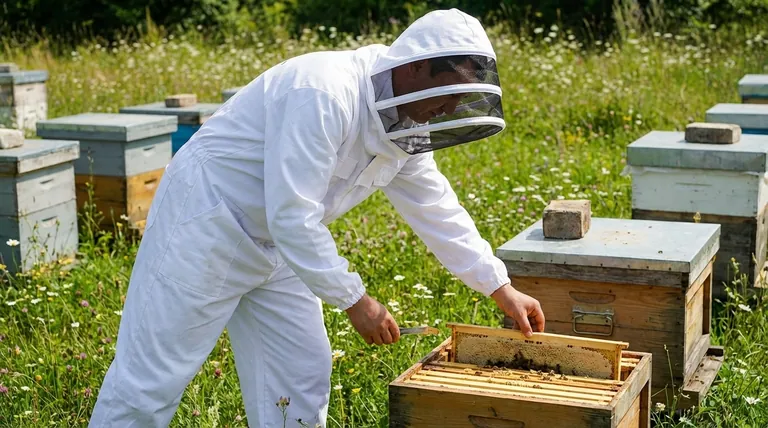At its core, choosing protective clothing with adequate freedom of movement is a critical decision that directly impacts your comfort, safety, and effectiveness. A suit that is too tight restricts your mobility, increases the risk of overheating, and can ultimately compromise the very protection it is meant to provide.
The proper fit for protective clothing is not about aesthetics; it is a functional requirement. A suit that allows for a full range of motion prevents dangerous mistakes and makes your work safer and more efficient.

The Dual Purpose of Protective Gear
Protective clothing, especially in a field like beekeeping, has two equally important functions. Ignoring one can undermine the other.
The Obvious Goal: Protection
The primary and most obvious purpose of the gear is to create a physical barrier. It is designed to prevent stings and keep you safe from the specific hazards of your work environment.
The Overlooked Goal: Enabling Work
The second purpose is to allow you to perform your tasks effectively and safely. If your gear hinders your ability to move, bend, and lift, it fails this crucial test and can introduce new risks.
How a Poor Fit Compromises Your Safety
Many assume a tighter fit is more secure, but the opposite is often true. Restrictive clothing creates a cascade of problems that can turn a routine task into a hazardous one.
The Risk of Overheating
A tight-fitting suit traps heat and moisture against your body. This lack of airflow significantly increases your core temperature, which can lead to heat stress, fatigue, and poor decision-making.
Reduced Mobility and Clumsy Movements
When your clothing fights against you, every movement is a struggle. This restricted mobility can cause you to make sudden, jerky motions, drop tools, or lose your balance—actions that can agitate bees or cause other accidents.
The Illusion of "Tighter is Safer"
A common misconception is that tight clothing offers better protection. In reality, fabric pulled taut against your skin makes it easier for a bee's stinger to penetrate. A looser fit maintains a gap between the material and your skin, providing a superior defense.
Understanding the Trade-offs: Loose vs. Baggie
Choosing the right fit is a matter of balance. The goal is a suit that is loose but not dangerously oversized.
The Ideal: Room for Movement
Your suit should be loose enough to allow you to squat, bend, and raise your arms without the fabric pulling tight anywhere. This ensures both comfort and a full range of motion.
The Hazard: Excessively Baggie
A suit that is too large can be a liability. Excess material can snag on equipment, branches, or hive components, creating a tripping or falling hazard. It can also create large gaps at the wrists, ankles, or neck if not secured properly.
Making the Right Choice for Your Goal
When selecting your gear, prioritize function over form. Test the fit by mimicking the movements you will perform during your work.
- If your primary focus is maximum safety and comfort: Choose a suit one size larger than your normal clothing to ensure ample room for movement and critical airflow to prevent overheating.
- If your primary focus is efficiency and precision: Select a fit that allows for unrestricted movement, preventing clumsy actions and ensuring you can work calmly and deliberately.
Ultimately, your protective clothing should feel like a tool that helps you, not a burden you have to fight against.
Summary Table:
| Key Factor | Impact of Poor Fit | Benefit of Proper Fit |
|---|---|---|
| Mobility | Restricted movement, clumsy actions | Full range of motion, precise work |
| Thermal Regulation | Trapped heat, risk of overheating | Improved airflow, prevents heat stress |
| Protection Level | Taut fabric increases sting penetration risk | Loose fit creates a defensive gap from skin |
| Overall Safety | Introduces new risks like snagging or falling | Enhances comfort and reduces mistakes |
Work Safely and Efficiently with HONESTBEE
Your protective gear should be an asset, not a liability. At HONESTBEE, we supply commercial apiaries and beekeeping equipment distributors with wholesale-focused operations. Our protective clothing is designed specifically to provide the perfect balance of maximum protection and unrestricted mobility, helping you prevent overheating and work with precision.
Ready to equip your team with gear that enhances safety and efficiency? Contact HONESTBEE today to discuss your wholesale needs and discover the right fit for your operation.
Visual Guide

Related Products
- Cotton Beekeeping Suit and Round Hat with Veil Bee Keeper Protective Gear
- White Beekeeping Protective Suit and Hat with Fencing Veil for Beekeepers
- Economy Polyester Beekeeping Jacket with Veil and Hat
- Beekeeping Jacket with Hood and Veil for Beekeepers
- Heavy Duty Cowboy Beekeeper Hat with Visibility Veil Outdoor Professional Beekeeping Protective Gear
People Also Ask
- What are bee suits made of? Choosing the Right Material for Maximum Protection & Comfort
- Why is white the predominant color in bee suit designs? | Key to Hive Calm & Beekeeper Safety
- What are the benefits of a fully ventilated beekeeping suit? Stay Cool and Protected in Hot Climates
- What is recommended for beginners in beekeeping regarding protective clothing? A Complete Safety Guide for New Beekeepers
- Why is a jacket with a hat veil recommended for beekeepers? Essential Protection for Your Face and Neck



















